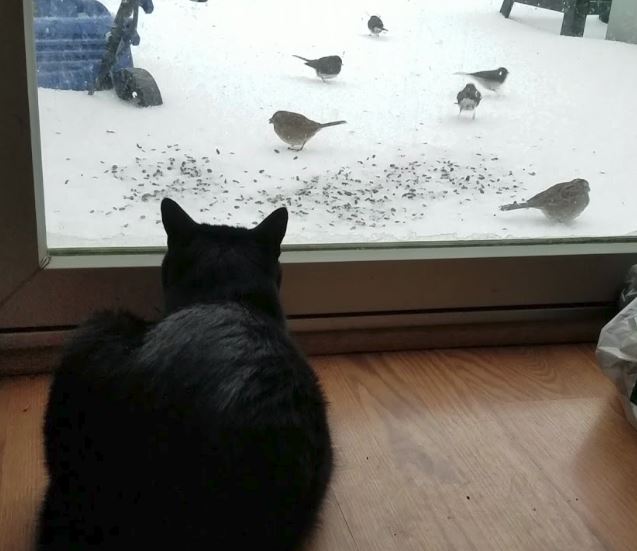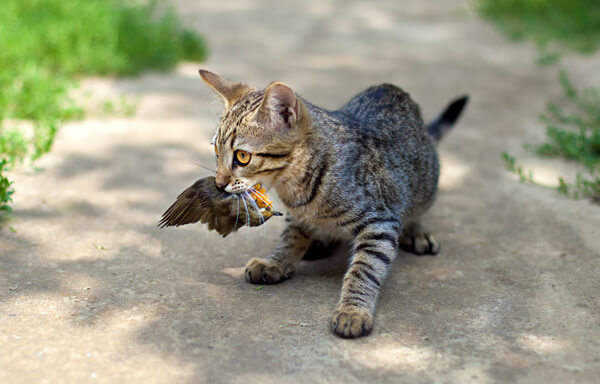Birds & Cats: The Inconvenient Facts
Cats present one of the biggest dangers to wild birds.
Free-ranging felines kill between 2.5 and 4 billion birds every year in the United States. Except for habitat loss, cat predation is the greatest source of mortality for birds. Many bird species nest and feed on the ground, not in the trees, making them even more vulnerable. The bacteria in cat saliva are toxic to birds, so even if a cat does not immediately kill a bird, its bite often leads to infection and death. Cats are natural and effective predators and will hunt for practice and “fun”—even when not hungry.
How you can help:
Bird Conservancy of the Rockies promotes keeping cats indoors at all times. This is the safest option for your pet, birds, and people. The average life expectancy of a free-roaming cat is just 2 to 5 years, compared to 14 years for a cat who lives indoors. Unhealthy cats also pose direct health risks to people, such as the transmission of parasites and diseases like rabies and toxoplasmosis.
If you must let your cat outside and can’t keep an eye on it yourself, take the following precautions to minimize danger:
 Shorten the amount of time spent outside. This reduces the amount of time your cat has to “play” with wildlife. Birds are most active at dusk and dawn, making them the most critical times to keep your cat inside.
Shorten the amount of time spent outside. This reduces the amount of time your cat has to “play” with wildlife. Birds are most active at dusk and dawn, making them the most critical times to keep your cat inside.- Trim your cat’s claws to make it harder to climb trees.
- Don’t feed stray cats. This encourages them to stay in your yard.
- Spay or neuter your cat. While this will not affect its hunting behavior, it will keep your cat from adding to cat populations.
- Keep your cat entertained with a windowed view of the outdoors where they can see the birds but not catch them. A secured screen porch works well, or consider a catio or similar enclosure.
- Go shopping! You can find a number of different products, such as colorful cat collars, cat bibs, and pens to keep cats contained, that claim to lessen the ability of your cat to catch wildlife.
- Spread the word to friends, family and neighbors about why keeping all cats indoors is the right thing to do.
Managing feral cats
Feral (“wild”) cats present special challenges as they often cannot be tamed and rehabilitated for indoor life. There are an estimated 60 million feral cats in the U.S. Each year, hundreds of thousands of cats are euthanized by humane societies and animal shelters because there are not enough homes for them, regardless of demeanor. Catch-and-release programs, where feral cats are spayed/neutered and then set free again, are intended as a humane way to control cat populations. While compassionate and with the best intentions, the approach is flawed and fails to reduce cat numbers. This is especially the case with “managed” colonies where people regularly provide food. Research shows these colonies often increase in size, as more cats are attracted to the food (and other felines) and unsterilized animals continue to breed. Meanwhile, the cats are free to continue hunting local wildlife for many years.
Additional information
American Bird Conservancy’s Cats Indoors Campaign offers resources for individuals and community groups. Click the logo below for more information.
Further reading
- Why Curtailing Your Cat Is for the Birds (National Wildlife Federation)
- The Moral Cost of Cats (Smithsonian)
- The Impact of Free-ranging Domestic Cats on Wildlife (Nature Communications)
- Impacts of Feral and Free-Ranging Cats on Bird Species of Conservation Concern (American Bird Conservancy)
- The Cat’s Meow: Catios Provide Perfect Spot (U.S. Humane Society)



